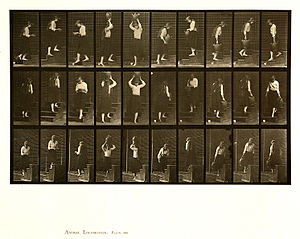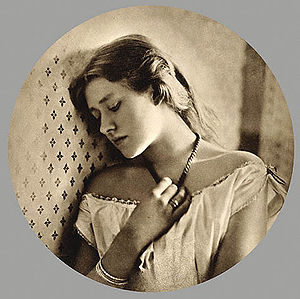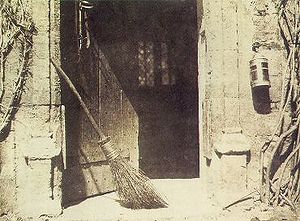Artistic media the camera arts/ART 102/Impact on other media
Let’s look at two examples from the different mediums to compare and contrast.
Gilbert Stuart’s 1809 painted portrait of Mrs. Harrison Gray Otis (above, left) not only records the sitter’s identity but also a psychological essence. There is a degree of informality in the work, as she leans forward in the chair, a shawl draped over one shoulder, hands clasped, with raised eyebrows and a slight smile on her lips. Her amusement is palpable and endearing.
In the photographic portrait of the English actress Ellen Terry (above, right), Julia Margaret Cameron captures the same informality and psychological complexities as Gilbert does, except this time the sitter leans against a patterned background, a simple white gown slips off her shoulders as she gently grasps a necklace with her right hand. Here the sitter’s gaze is cast downward, unsmiling, in a moment of reflection or sadness. The lighting, coming from the right, is used to dramatic effect as it illuminates the left side of Terry’s body but casts the right side in shadow.
One obvious difference is the lack of color in Cameron’s photo. Her use of black and white creates a graphic composition based on both dramatic and subtle changes in value. The first color photographs were developed as early as the 1860’s, but these early processes were impractical and of little value.
Painters worried that this new medium would spell the end to theirs. In reality, early photographers were influenced by popular styles of painting in creating their own compositions. Cameron’s staged photograph Queen Esther before King Ahasuerus from 1865 (below, left) mimics the Symbolist paintings of the time in both style and subject matter. They used mythology, dramatic poses and other Romantic themes to create visual worlds with dream like figures and dark emotions. You can see the similarity between Cameron’s photograph and George Frederic Watts’ painting Paolo and Francesca (below, right) from about the same time.
Early photographs were made from single plates of metal, glass or paper, each one painstakingly prepared, exposed and developed. In 1884, George Eastman invented transparent roll film; strips of celluloid coated with a light-sensitive emulsion. Four years later, he developed the first hand held camera loaded with roll film. The combination brought access to photography within the reach of almost anyone. Additional advances were made in lens optics and shutter mechanics. By the turn of the nineteenth century, the photograph represented not only a new artistic medium but also a record -- and a symbol -- of the Industrial age itself.





